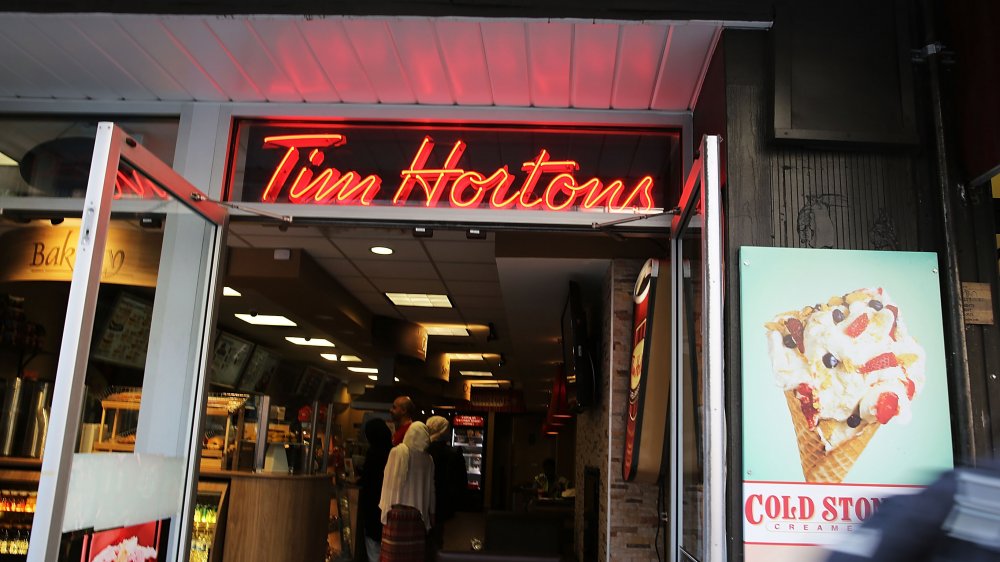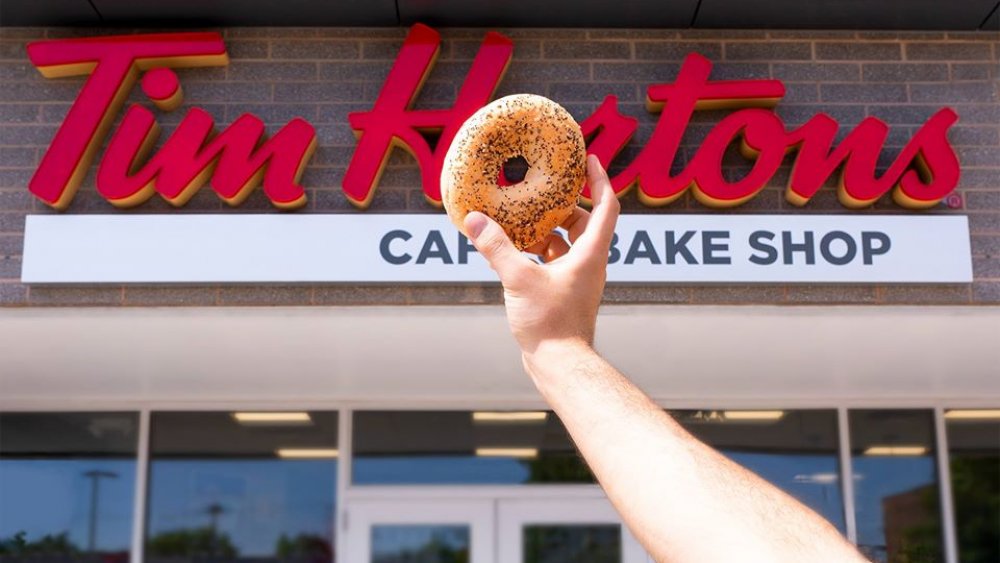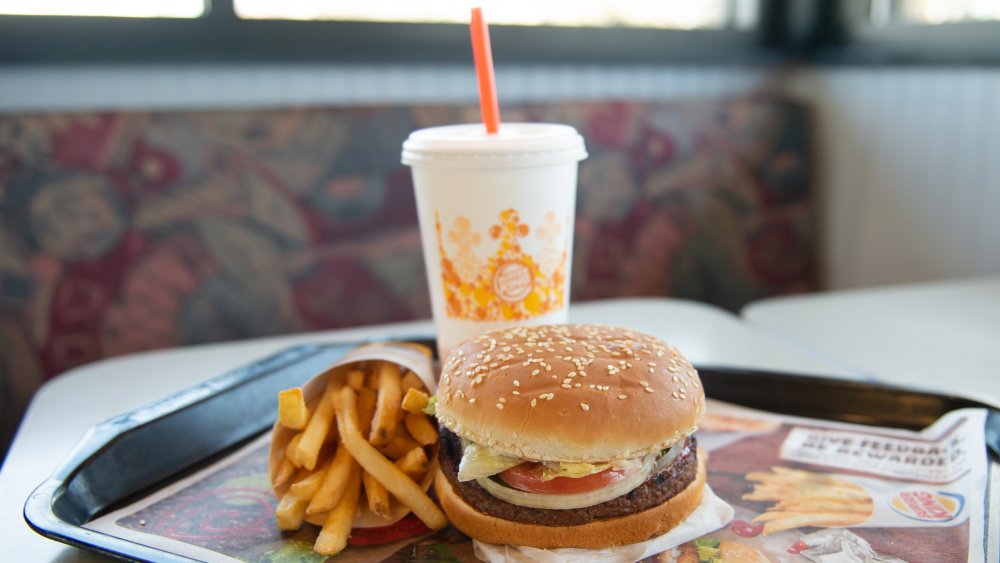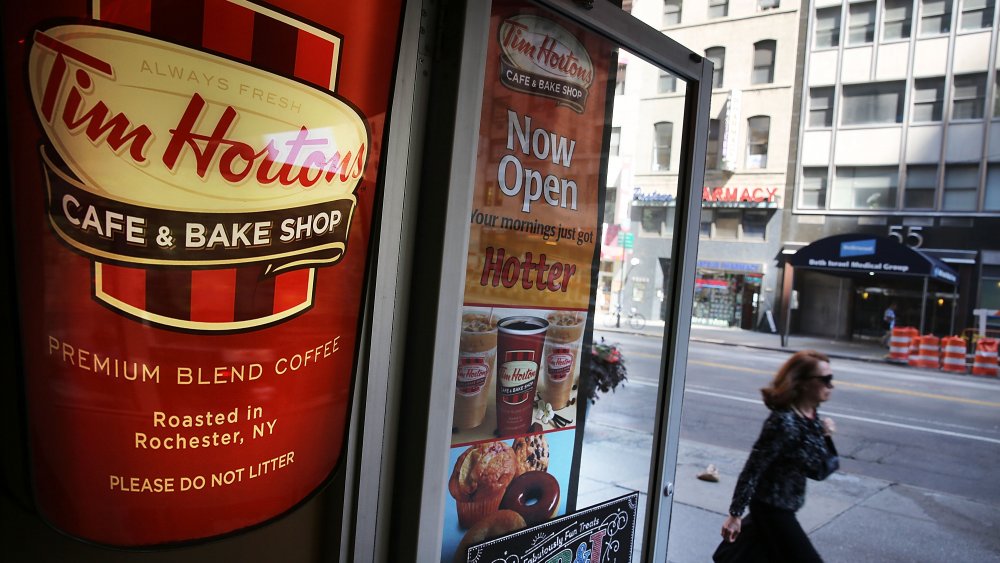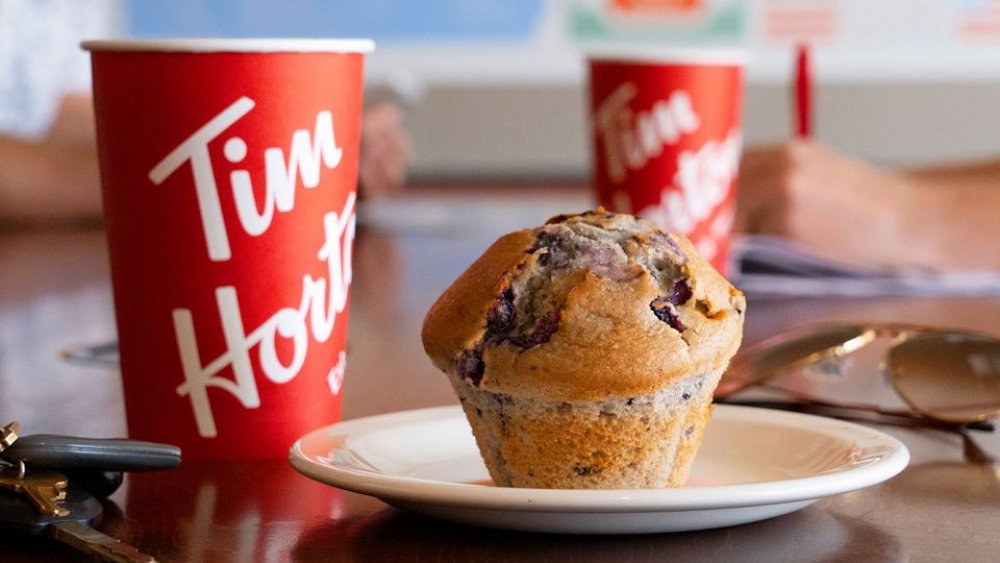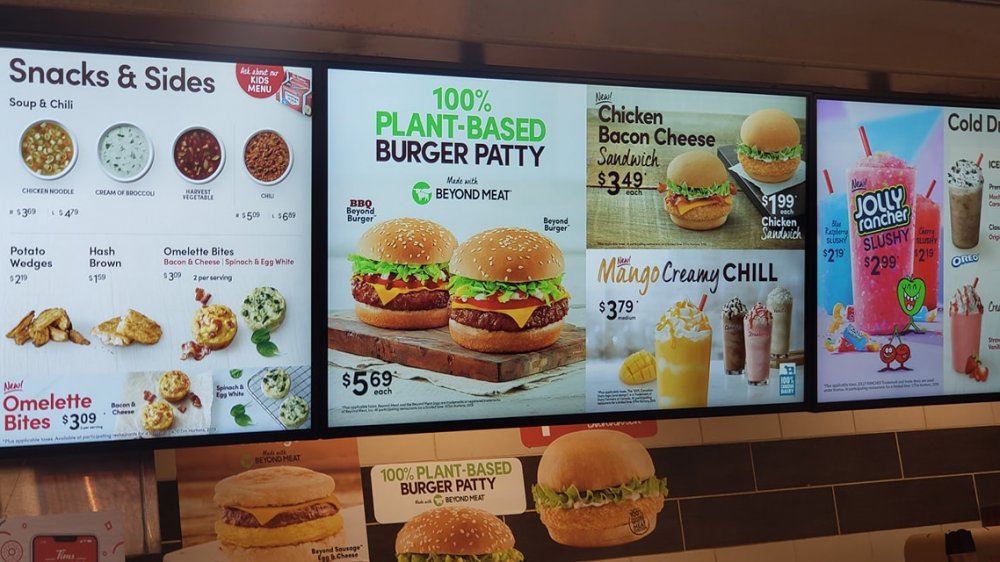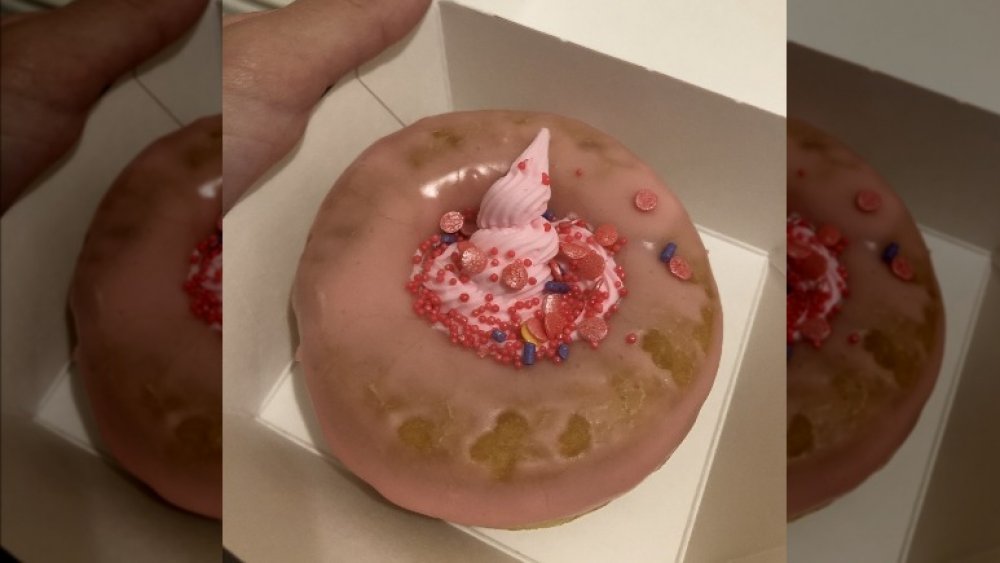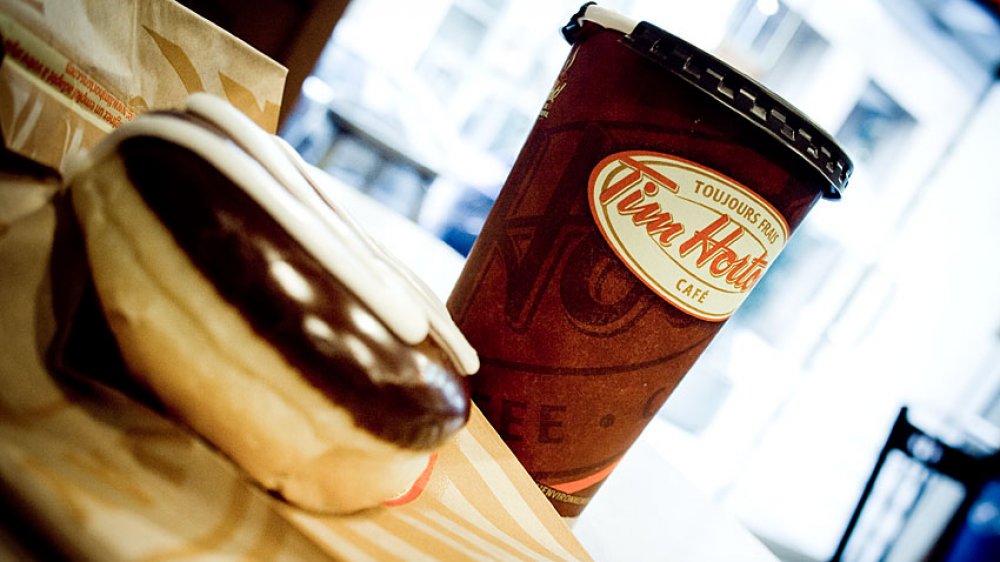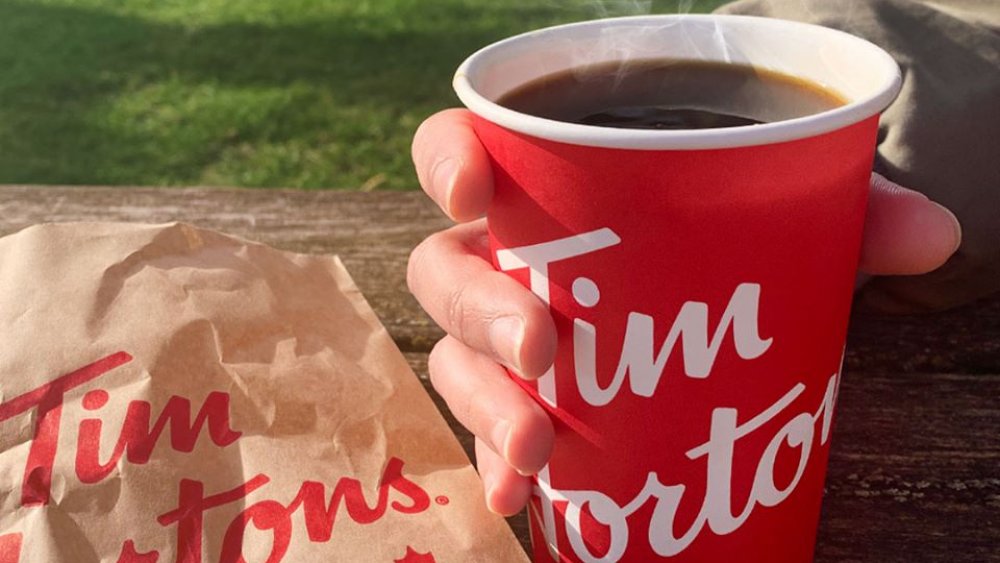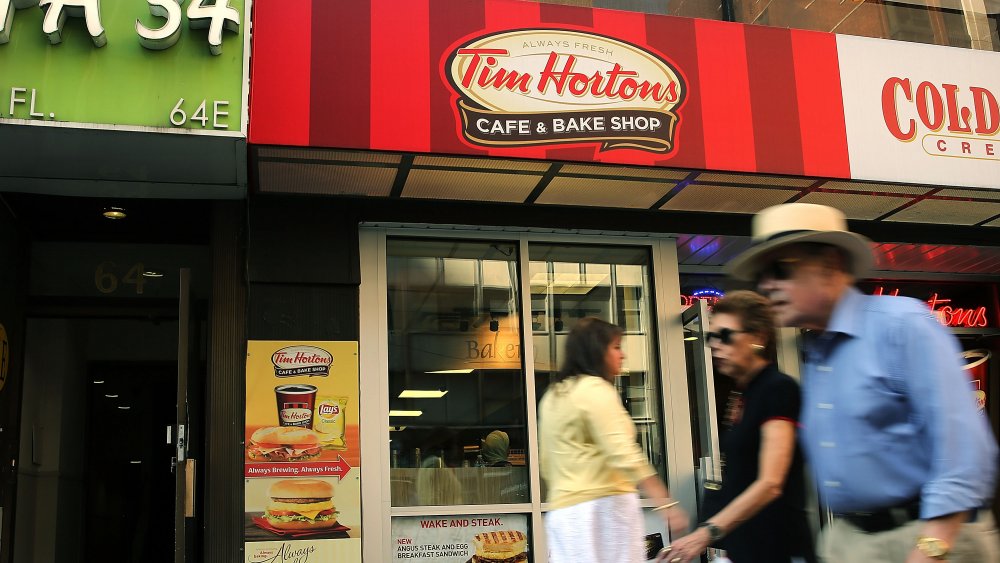The Real Reason Tim Hortons Is Struggling
Tim Hortons — the coffee and doughnut shop founded by the hockey superstar of the same name — has long been a staple for Canadians looking to get their morning caffeine or sugar rush. What started out as a small mom-and-pop storefront with just two donuts on the menu in Hamilton, Ontario, quickly grew into a national (and later international) powerhouse serving caffeinated Canadians all across the country.
But over the last couple of years, the chain has found themselves in a bit of trouble. Sales are down. Locations all throughout the United States have been closing, despite the company's efforts at globalizing. As numerous columnists across Canada have written, ol' Timmies just isn't all that cool anymore.
A survey conducted by the Canadian news magazine Maclean's revealed that Tim Hortons is no longer the favorite coffee shop in Canada — in fact, it's not even second or third, trailing in at fourth behind McDonald's, Second Cup, and Starbucks. With a recent, unexpected drop in sales at the end of 2019, the once-popular coffee shop appears to be headed into a slow and unfortunate decline. So where did this ill-fated institution go wrong?
This is the real reason Tim Hortons is struggling.
Slow sales at Tim Hortons surprised their parent company
In October 2019, The Toronto Star reported that Tim Hortons saw an unexpected and sudden drop in sales for the third quarter of the year. Analysts had predicted that the company would see a slight increase in revenue during that quarter, about 1 percent — but when October rolled around, it turned out that Tim Hortons' sales actually declined by 1.4 percent.
Restaurant Brands International Inc., the company which oversees Tim Hortons (among other fast food giants like Popeyes and Burger King), saw a general uptick in sales for its other brands —a 5 percent increase in year-over-year sales at Burger King (which The Star says they credit to the introduction of the Impossible Whopper in April 2019) and a 10 percent increase at Popeyes (surely due to the spike in popularity of their famous chicken sandwich).
But in spite of the increases at its other restaurants, according to The Star, Tim Hortons brings in about 60 percent of the RBI's total revenue, so the slump in sales at the coffee house isn't a great look for the parent company.
New corporate leadership angered Tim Hortons franchisees
Restaurant Brands International Inc. merged Tim Hortons with its other fast food brands in 2014, after RBI's parent company bought out the chain in a $12.5 billion deal. Shortly thereafter, the company tried its best to up the coffee shop's profits and decrease its costs. That sounds like a good, rational business plan, right? Not quite. In doing so, it seems like RBI cut a few too many corners, at the cost of alienating its franchisees.
According to the Financial Post, RBI introduced a stricter management system to the company, which franchisees weren't used to. Employees largely felt dissatisfied with the new direction — especially after a round of layoffs shattered employee morale.
According to Eater, the number of corporate employees dropped from nearly 40,000 to a little more than 1,000, mostly after they sold off company-owned locations and started depending more on franchisees to run restaurants. After that, required remodels of those now franchised locations were paid for at the expense of the franchisee.
That same disgruntledness made its way to the States shortly thereafter. Eater says about half of all the café's franchisees in the United States decided to take legal action against RBI in 2017, after alleging that the company collected around $700 million from franchise owners for marketing and promotional materials, but actually used it for other expenses largely unconnected to Tim Hortons.
Tim Hortons cafes aren't cool places to hang out
In the response to the company's dip in profits in 2019, RBI CEO Jose Cil scapegoated the coffee shop's weakness in the cold drinks and sandwich categories.
As BNN Bloomberg reported, Tim Hortons has struggled to generate hype around its menu items like its sister companies have — Tim's menu doesn't exactly have much for the general populace to latch onto in the way they did for Popeyes' chicken sandwich. But it doesn't seem like the lacking cold drinks and lunch options are the only factor at play here.
Tim Hortons' competition — places like Starbucks and Dunkin' — have done a much better job at remaining relevant among millennials, without making drastic shifts in their lunch and cold drink offerings. One major reason for that may be the ambiance.
According to Forbes, Starbucks is continuing to grow, thanks to the company's marketing schemes and efforts to create a pleasant atmosphere for customers to relax in. Think about it: you can walk into a Starbucks at pretty much any time of day, to find students catching up on classwork or writers click-clacking away at their laptops.
Tim Hortons doesn't have that same effect on people — it's not necessarily because the coffee and pastries at Starbucks are any better. It's just that Tim Hortons hasn't put nearly as much effort into making its cafés a cool and comfortable place for people to hang out.
Tim Hortons doesn't promote trendy items well enough
Part of Tim Hortons' appeal for so many decades has been its down-to-earth, no-frills-attached approach to customer service — since its national expansion in the late '60s and '70s, it's gone down in the Canadian cultural ethos as the everyman's cup of coffee. But that's not what the people want nowadays. Fast-casual dining is no longer as dominant as it once was, and customers are seeking out more boutique-style dining experiences with more careful and conscientious service.
Tim Hortons has a number of menu items which, if marketed properly, could be immensely successful in this ever-shifting dining landscape — the problem is, no one knows about them. Take, for instance, the Homestyle Biscuits, which, according to the National Post, are vegan. Tim Hortons doesn't market this at all though. This is a talking point that younger customers might be all over, considering the huge increase in the popularity of veganism in the last couple of years. In its failure to simply let people know they're keeping up with the trends — Tim Hortons is going down the wayside.
Independent, specialty coffee shops may be taking away from Tim Hortons
Sure, Tim Hortons has added plenty of menu items to its repertoire since its modest beginnings in the '60s. But the quality of coffee has remained rather static. It's not much different from Starbucks or other second-wave, chain coffee shops around the country: the focus is less on the quality of the coffee beans and more on the quantity. While that was fine for most customers just a couple decades ago, tastes have changed quite a bit, as coffee fanatics are drinking more gourmet, third-wave coffee than ever before, according to The Washington Post.
Third-wave (aka specialty) coffee shops are all about high quality, ethically sourced coffee — think local, independent coffee shops that focus on educating customers about the origin of their beans. While coffee from chains like Tim Hortons is certainly a couple notches above your grandfather's bitter and smoky morning cup of Folger's, it pales in comparison to the vibrant, fruity notes of a delicately crafted pour-over made with single origin beans at the artsy, indie café downtown.
And customers are catching on: about 61 percent of Americans are drinking gourmet coffee on the regular, which the National Coffee Association defines as possessing "at least one distinctive attribute in the body, flavor, aroma or acidity." Timmie's doesn't spend much time talking about the flavors and aromas of their coffee — or even where it comes from — so they likely fall short for those customers looking for something a little more special.
Tim Hortons' is chasing away their blue collar customer base
In its last-ditch efforts at maintaining a semblance of coolness, Tim Hortons has introduced a few new menu items in an effort to appeal to the younger generation of consumers — things like nitro cold brew and omelette bites. But the problem is that Tim Hortons has been known for a sort of simplistic, kitschy aesthetic since its inception — a place that caters to the working class. In adding all these newfangled dining options, they're chasing off their old customer base — and what they're offering isn't good enough to bring in new customers.
In a 2019 article about how Tim Hortons lost its way, MacLean's columnist Corey Mintz argues that recent additions like the aforementioned omelette bites and waffle sandwiches have the potential to be great additions to the menu. But because of the café's huge network of locations (it's the second largest coffee chain in the world, by the way, with more than 4,000 brick and mortar shops across nine countries), they have to forego quality a bit in favor of consistency: this means using pre-made foods to streamline the process.
They're getting rid of old standbys that regular customers came in for to make way for newer, sub-par items. Just like its second-wave coffee beans fail to live up to the more artisanal contemporary tastes, the company's half-baked attempts at creating a more expansive and lavish food menu have also fallen short.
Tim Hortons' foray into plant-based meat was a failure
Perhaps an extreme example of Tim Hortons' failed efforts at riding on the coattails of contemporary dining trends is its Beyond Burger experiment. We all know Beyond Meat has been having a moment — even non-vegetarians love the plant-based burger, for its ethical sourcing, environmental sustainability, and near identical mouthfeel to real beef. In July 2019, the coffee house decided to hop on the vegan meat train, inspired by other fast food restaurants' take on vegan burgers, like sister-company Burger King's Impossible Whopper.
Only a couple of months later, though, Tim Hortons pulled the Beyond Burger from all locations except for some in British Columbia and Ontario (which coincidentally have Canada's highest density of vegans and vegetarians respectively).
And then in January 2020, Yahoo Finance reported that Tim Hortons decided to pull the plug on Beyond Meat at all of its locations, amid a general decline in interest in the plant-based meats.
Sylvain Charlebois, a professor of food distribution and policy at Dalhousie University, told the Canadian Broadcasting Company that introduction of the Beyond Burger to Tim Hortons locations was a lot like McDonald's short-lived forays into the pizza world. Just like people associate McDonald's with hamburgers (and definitely not pizza), people associate Tim Hortons with coffee and doughnuts — most of us don't actively seek out a Tim Hortons for our daily burger fix.
The menu items at Tim Hortons fail to live up to their glossy marketing products
It seems like even when Tim Hortons tries to focus on the things they do right — like donuts — they've been falling short.
In July 2019, Tim Hortons launched an experimental Innovation Café concept in Toronto, where the coffee shop had a more expansive menu, testing out all sorts of different, experimental donut ideas like maple bacon donuts and lunch items such as... lobster bisque?
Most of these menu items have yet to make it into mainstream Tim Hortons locations, but the trio of Dream Donuts that did — dulce de leche, chocolate truffles, and strawberry confetti — have left a lot to be desired.
Promotional images used in marketing the Dream Donuts featured vibrant colors and gorgeously piped frosting, but when many customers went to their local Tim Hortons to pick some up, the dull and uninteresting presentation failed to live up to their expectations. Many people took to social media to post about their Dream Donut expectations vs. reality, and in a column for MacLean's Mintz wrote that the piping on the donuts he tried was reminiscent of "that first day of baking in cooking school, when most of us struggled to fit a piping bag with a star tip."
And even in locations where the presentation was admirable, the taste left a lot to be desired — many claim the donuts are too sweet and artificial tasting, and not something they would order again.
The new lid design at Tim Hortons has been disastrous
Back in 2018, the company introduced a new lid design that was met with disappointment from its customers — even Justin Bieber had a couple things to say about it. In a recent Instagram post, the disgruntled Canadian singer wrote "these new lids are uncomfortable on the mouth, and you get very little liquid each drink it's a damn outrage and needs to be changed back." The singer even conducted an Instagram poll, to which 70 percent of respondents said they too missed the old lids.
The lids were introduced as a response to Tim Hortons customers complaining about leakage from the old lids, a report from the CBC says. Many even referred to the old, flattened lid design as "double dribble," because patrons would inevitably spill a little bit of their coffee out onto their shirts as they sipped on their beverage. But many customers found themselves in an even bigger pickle with the new lids: they're even more prone to spillage as some people have pointed out on social media, and they also don't allow for as much coffee to come out in one sip.
According to the CBC, some customers are jokingly selling "antique" Tim Hortons lids online for up to $200, because customers miss the old design so much. Perhaps Tim Hortons customers are getting their coffee someplace where the lids are less of a hassle.
Tim Hortons had a burger guy leading the way
Amidst all the controversy surrounding the global coffee giant, as well as the dip in sales, it should come as no surprise that Tim Hortons is scrambling to change things up in response. One of the first big changes within the company? Well, as of March 2020, Alex Macedo, the current global brand president of Tim Hortons will no longer be working with the company, as CBC reported at the end of 2019.
Macedo joined the Tim Hortons team after a long career with Burger King — maybe, just maybe, having burger guys run a coffee shop isn't the greatest business plan. While he was successful at growing Burger King's brand, he may have brought a little too much of his burger-related experience to Tim's (like that whole Beyond Burger fiasco).
While RBI's CEO has insisted that relations between the company and Macedo remain amicable and that he "has all our best wishes as he leaves RBI," news reports have been vague about why Macedo is leaving the company — however, the timing of his departure announcement comes suspiciously close to the controversies surrounding Tim Hortons' alleged poor treatment of franchisees and the dip in sales.
Instead, RBI has appointed Axel Schwan, the regional president of the company's U.S. and Canada branches to step up to the position. Schwan has worked with the Tim Hortons brand for quite some time now, so hopefully he can help the company get back on its feet, with a more coffee-centric approach.
But not all hope is lost for Tim Hortons
But it's not all doom and gloom for the massive coffee chain. While the company has clearly struggled with its recent nosedive in sales and potentially wasting even more money on gimmicky products that really only served to confuse and disappoint customers, the company's leadership hasn't given up on reviving the classic java shop's legacy just yet.
In January 2020, RBI's chief corporate officer Duncan Fulton announced that Tim Hortons would be returning to its roots. It appears the company's leadership has come to the realization that many of us came to months ago. Talking to the Financial Post, Fulton said, "While it's interesting to test in burgers and cereal, it's not what we're famous for." The company has, without a doubt, been having a bit of an identity crisis, but it appears that they're getting back on their feet as they come to realize what customers really want: the old Tim Hortons that they know and love. Well, that and maybe just a slightly better marketing team.
